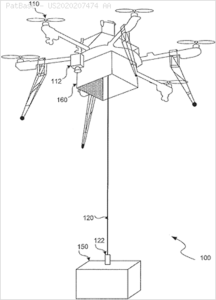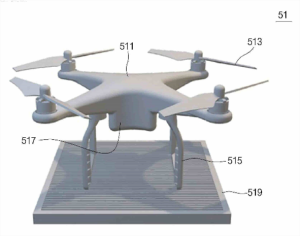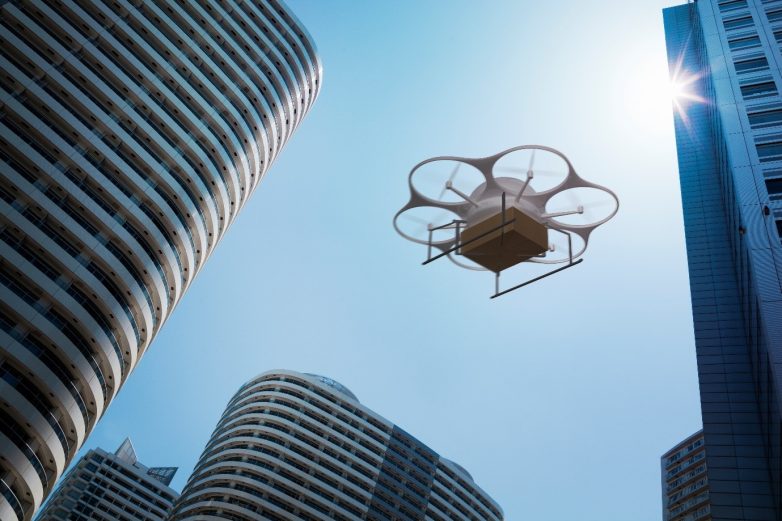Innovative Drone Technologies & Their Patents
What is a Drone (UAV)?
Drones, also known as Unmanned Aerial Vehicles (UAVs), are flying robots that can be piloted remotely by an operator or can fly autonomously using programmed flight plans. They are fitted with onboard sensors and GPS systems which allow them to navigate through space without colliding with obstacles.
Growing in popularity in recent years, what was once developed for military purposes has since been adapted to become a mainstream technology in a variety of industries including:
- Healthcare
- Agriculture
- Delivery
- Entertainment
- Photography & videography
- Surveillance
And more.
How do Drones Work?
Drones primarily serve two fundamental functions: flight and navigation. In the context of flight, drones require a power source, which is usually a rechargeable battery. They are equipped with rotors or propellers and have a lightweight composite frame to optimise manoeuvrability and minimise weight.
The second core function involves navigation, facilitated by a controller. Operators use remote controls to command the drone for take off, flight, and landing. These controllers communicate with the drone through radio waves, often utilising technologies like Wi-Fi. Combined, these components and functions enable drones to take to the skies, navigate, and carry out various tasks, from recreational flying to professional applications.
Types of Drones
There are numerous different types of drone, each with their own features making them more useful in certain situations.
Single-Rotor Helicopter Drones
- Single-rotor drones have one large rotor for lift and a smaller tail rotor for stability.
- They are typically larger and capable of carrying heavier payloads.
- Single-rotor drones offer longer flight times and better efficiency compared to multi-rotor drones.
- Used in professional aerial photography and videography, surveillance and inspection, and in search and rescue operations.
Multi-Rotor Drones
- Multi-rotor drones have multiple rotors (usually four, six, or eight) for lift and stability.
- They are known for their stability, agility, and ease of control, making them ideal for beginner pilots.
- Multi-rotor drones are versatile and widely used for a range of applications.
- Used in hobbyist aerial photography and videography, mapping and surveying, and to monitor crop fields.
Fixed-Wing Drones
- Fixed-wing drones have a streamlined, plane-like design for efficient forward flight.
- They require a runway for take off and landing and can cover long distances.
- Fixed-wing drones are known for their endurance and can stay in the air for extended periods.
- Used for large-area mapping and surveillance, wildlife monitoring and conservation, and military operations.
Vertical Take-Off & Landing (VTOL) Drones
- VTOL drones combine the vertical take off and landing capabilities of helicopters with the forward flight of fixed-wing drones.
- They are highly versatile, capable of hovering like a helicopter and covering long distances in fixed-wing mode.
- VTOL drones are used in various professional and military applications. Also best used for urban environment inspections, surveillance and reconnaissance, and delivery of goods in hard-to-reach areas.
Innovations in Drone Technology
The development of drones as mainstream use has resulted in an increased number of patent applications involving drone technology. For the last 15 years, the number of grants involving drone technology has been steadily increasing, reaching an all-time high in 2022. China has dominated the drone technology market accounting for 64% of all drone-related grants in 2022. With the increase in patent applications and grants and the widespread use of this technology, the commercial drone market is expected to be worth $501.4 billion by 2028.

Considering all the new technology that is emerging in the drone industry, take a look at three exciting innovations that have risen from drone patent grants.
Drone Delivery
A contact-free delivery system during COVID put pressure on scientists to push the boundaries and modernize the outdated delivery system. Drone deliveries are now possible thanks to a recent patent granted to Flirtey, which recently changed its name to SkyDrop, which provides hardware and software for autonomous last-mile drone delivery. The patented drone enables package lifting and lowering while the drone is hovering overhead. The company’s mission is to provide instant delivery for everyone. Currently, the company is focusing on safety and supplementary goods to support drone delivery, such as parachute deployment, emergency UAV facilities, and aerial vehicle detecting systems. Although their applications are still pending, many companies, including Google and Amazon, were competing to establish a drone delivery system for commonly purchased goods.

Air Purifier Drones
With climate change and air pollution at an all-time high, scientists have developed a method to purify the air using drones. The technique used detects and efficiently purifies highly contaminated areas. Purification can be performed automatically or by requesting permission from the user terminal. This technology includes a location transmitter, an air purifying box, and an air pollution measurement sensor. All this data is sent to the user terminal, which can be analyzed for comparison purposes. The innovation mentioned above is currently not commercially used, but it has the potential to of being utilized in the near future.

Drone Cameras Built on Smartphones
Cameras have been attached to drones since their first use. Its technology was often associated with a bulky apparatus that is often stored alone without much interaction with other technologies. Last year, Vivo mobile communication company was granted a patent application for a smartphone device with a built-in camera that also functions as a drone. The technology, which is a lot smaller than other drones on the market, is stored in the smartphone’s inner cavity. The drone can be deployed and operated directly from the device, enabling a range of integrated functions and the rapid exchange of information.

The innovations mentioned above are examples of ways in which scientists and engineers are revolutionising our day-to-day through drone technology. It’s impossible to predict how many different applications there will be for drones in the future, however, it’s clear that there are no limitations as to what might be possible.
Explore Drone Technology Patents with Minesoft
Minesoft’s global patent information solutions help organisations all over the world accelerate their innovation processes and increase their ROI by leveraging the power of patent data. Visit our website for more information on how our solutions can help your team. Software such as Patbase can help you to search and analyse patent information across entire industries. With Minesoft Origin, you can leverage the power of AI to provide you with patent insights to inform strategic plans. If you are interested in exploring our solutions further, please feel free to contact our expert team, or book a free demo today.

